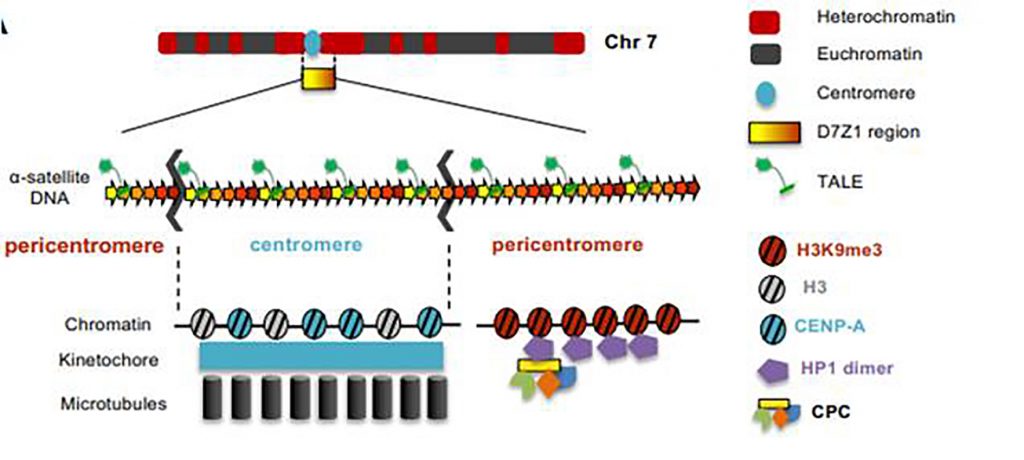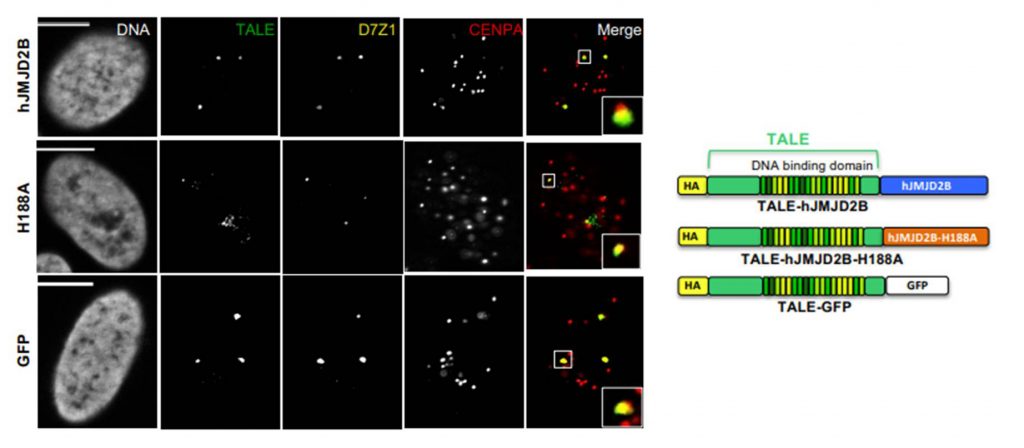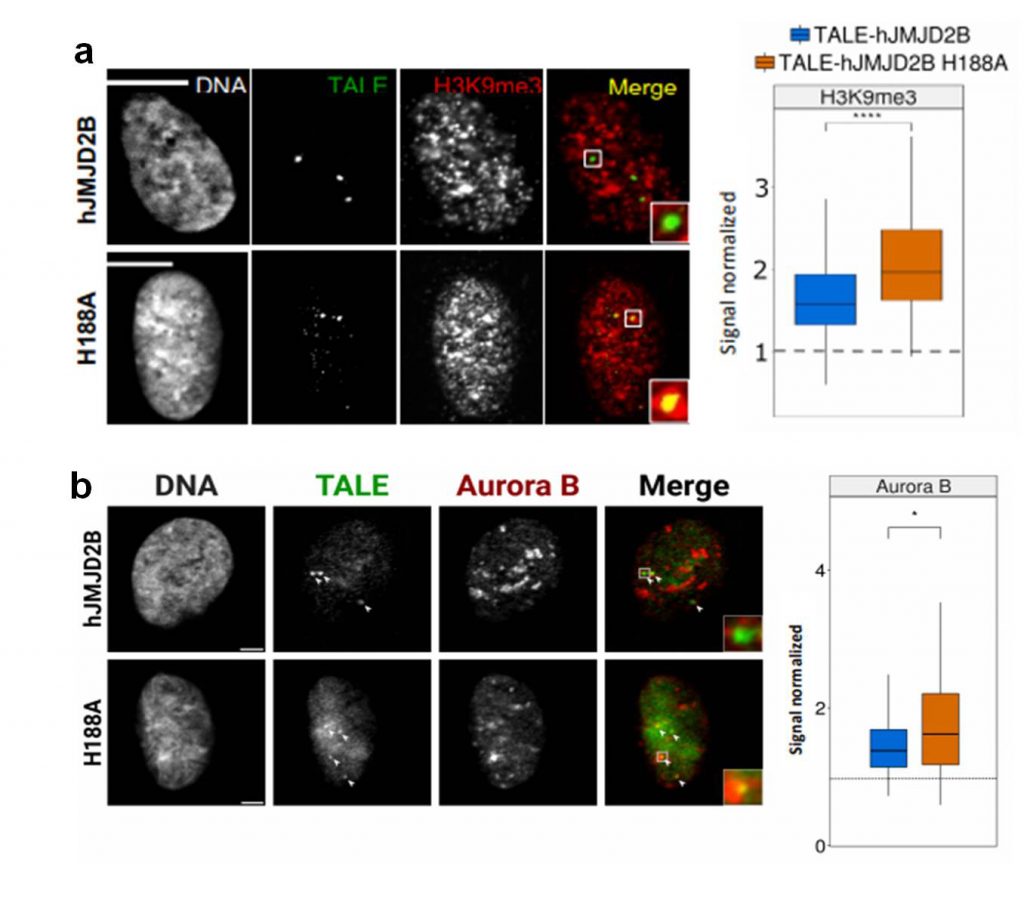Epigenetic rewriting at centromeric DNA repeats leads to increased chromatin accessibility and chromosomal instability
Preprint posted on 23 February 2021 https://www.biorxiv.org/content/10.1101/2021.02.22.432244v1
Article now published in Epigenetics & Chromatin at http://dx.doi.org/10.1186/s13072-021-00410-x
Categories: cell biology, molecular biology
Context1-5
Centromeres consist of tandem repeated DNA sequences and enable chromosome segregation during mitosis and meiosis. Centromeres are a classic example of epigenetically defined genomic loci that contain histone H3 variant CENP-A nucleosomes. While the core centromeric DNA is wrapped by CENP-A containing nucleosomes interspaced by histone H3 containing nucleosomes, the pericentromeric DNA is wrapped by histone H3 nucleosomes (fig.1).
The core centromeric region seems to be transcriptionally permissive and the pericentromeric region is transcriptionally repressed. This results in differential histone post-translational modifications at the core and pericentromeric regions. Also, post-translational modifications of histone H3 support centromere transcription, integrity, and function. For example, euchromatin histone H3 marks (e.g., H3K36me2/3, H3K9ac) were detected at the core centromeric region. On the other hand, heterochromatin mark histone 3 lysine 9 trimethylation (H3K9me3) is present at the pericentromeric region; removing or preventing the deposition of the H3K9me3 mark induces centromere DNA instability and aneuploidy. However, modifying histone marks (here H3K9me3) specifically at the centromeres without disturbing genome-wide patterns, remains a challenge. Thus, in the current preprint, the authors investigated the impact of H3K9me3 specifically at an endogenous centromere using a targeted histone lysine demethylation.
Experimental system
The authors fused a histone lysine demethylase (hJMJD2B) to the DNA binding domain of a Transcription activator-like effector (TALE6) directed to bind α-satellite repeats present in the centromeric region of human chromosome 7 (or DZ71 array). As controls, they used a catalytically inactive mutant (hJMJD2B-H188A), and a GFP-tagged TALE. They expressed these constructs in U2OS cells either transiently or under a doxycycline-inducible system for 24-48 hrs.

Key findings
- First, they found four hJMJD2B- or H188A- TALE foci in U2OS cells co-stained with CENP-A antibody or DZ71 FISH probe (fluorescence in situ hybridization) as U2OS are mostly tetraploids (fig.2). Thus, they reasoned that both wild-type (hJMJD2B-TALE) and mutant (H188A-TALE) histone lysine demethylase bind to the pericentromeric regions of chromosome 7.

Fig.2: U2OS cells expressing either the TALE-demethylase (top), its point mutant (middle), or the TALE-GFP (bottom). Sketch of the different constructs of TALE fusion proteins used in this study. - Then they found reduced H3K9me3 staining specifically at the DZ71 array in cells expressing the hJMJD2B-TALE but not the H188A-TALE (fig.3a). Additionally, they demonstrated a concomitant increase in H3K9me2 and H3K9me1 staining at the DZ71 array associated with the loss of H3K9me3. Also, they suggest an increase in chromatin accessibility at the DZ71 array followed by hJMJD2B-TALE
- They further report induction of chromosome segregation defects in hJMJD2B-TALE expressing cells as scored by the change in ploidy of chromosome 7 but not of a control chromosome (Chr. 11). Also, they demonstrate reduction of chromosome passenger complex (CPC7) proteins (e.g., INCENP, Aurora B kinase) and heterochromatin protein 1 (HP1α) in the vicinity of hJMJD2B-TALE foci (fig.3b). Thus, they suggest that suboptimal levels of H3K9me3 at the centromere of chromosome 7 specifically induce chromosome segregation defects of that chromosome.

Fig. 3: U2OS cells expressing the TALE-demethylase (top) or the catalytically inactive mutant (bottom). DNA is visualized using Hoechst, the TALE (shown in green), H3K9me3 (a), and Aurora B (b).
Conclusion and perspective
To manoeuvre epigenetic information – histone post-translational modifications and DNA/RNA methylation – specifically at endogenous centromeres without influencing genome-wide gene expression is challenging. The current preprint tries to address this by using a customized genetically engineered histone modifier that can modulate the histone H3 heterochromatin mark at a specific centromere. Also, one could edit DNA methylation at centromeres leveraging cutting-edge CRISPR technologies (here8). Considering that centromeres go through (non-canonical) transcription, it would be also interesting to investigate if and how centromere RNA methylation regulates its function. Future work could build on this to reveal interesting facts about how modulating the epigenetic landscape at the centromeres impact its transcription, replication, and function in a cell-cycle-dependent manner.
Acknowledgments
Thanks to Judith Lopes and Sheldon Decombe to comment on this preLight, and to all the authors for their support.
All figures used in this preLight are taken directly from Decombe S et. al., 2021 under a CC-BY 4.0 international license.
References
- https://doi.org/10.1083/jcb.202005099
- https://doi.org/10.1080/15384101.2017.1325044
- https://doi.org/10.1016/S0092-8674(01)00542-6
- https://doi.org/10.1074/jbc.M505323200
- https://doi.org/10.1007/s10577-016-9539-3
- https://doi.org/10.1126/science.1178817
- https://doi.org/10.1038/nrm3474
- https://doi.org/10.1016/j.cell.2021.03.025
Posted on: 18 April 2021 , updated on: 21 April 2021
doi: https://doi.org/10.1242/prelights.27981
Read preprintSign up to customise the site to your preferences and to receive alerts
Register hereAlso in the cell biology category:
Clusters of lineage-specific genes are anchored by ZNF274 in repressive perinucleolar compartments
Structural basis of respiratory complexes adaptation to cold temperatures
RIPK3 coordinates RHIM domain-dependent inflammatory transcription in neurons
Also in the molecular biology category:
Clusters of lineage-specific genes are anchored by ZNF274 in repressive perinucleolar compartments
Nanos2+ cells give rise to germline and somatic lineages in the sea anemone Nematostella vectensis
Plant plasmodesmata bridges form through ER-driven incomplete cytokinesis
AND
Plasmodesmata act as unconventional membrane contact sites regulating inter-cellular molecular exchange in plants
preLists in the cell biology category:
BSCB-Biochemical Society 2024 Cell Migration meeting
This preList features preprints that were discussed and presented during the BSCB-Biochemical Society 2024 Cell Migration meeting in Birmingham, UK in April 2024. Kindly put together by Sara Morais da Silva, Reviews Editor at Journal of Cell Science.
| List by | Reinier Prosee |
‘In preprints’ from Development 2022-2023
A list of the preprints featured in Development's 'In preprints' articles between 2022-2023
| List by | Alex Eve, Katherine Brown |
preLights peer support – preprints of interest
This is a preprint repository to organise the preprints and preLights covered through the 'preLights peer support' initiative.
| List by | preLights peer support |
The Society for Developmental Biology 82nd Annual Meeting
This preList is made up of the preprints discussed during the Society for Developmental Biology 82nd Annual Meeting that took place in Chicago in July 2023.
| List by | Joyce Yu, Katherine Brown |
CSHL 87th Symposium: Stem Cells
Preprints mentioned by speakers at the #CSHLsymp23
| List by | Alex Eve |
Journal of Cell Science meeting ‘Imaging Cell Dynamics’
This preList highlights the preprints discussed at the JCS meeting 'Imaging Cell Dynamics'. The meeting was held from 14 - 17 May 2023 in Lisbon, Portugal and was organised by Erika Holzbaur, Jennifer Lippincott-Schwartz, Rob Parton and Michael Way.
| List by | Helen Zenner |
9th International Symposium on the Biology of Vertebrate Sex Determination
This preList contains preprints discussed during the 9th International Symposium on the Biology of Vertebrate Sex Determination. This conference was held in Kona, Hawaii from April 17th to 21st 2023.
| List by | Martin Estermann |
Alumni picks – preLights 5th Birthday
This preList contains preprints that were picked and highlighted by preLights Alumni - an initiative that was set up to mark preLights 5th birthday. More entries will follow throughout February and March 2023.
| List by | Sergio Menchero et al. |
CellBio 2022 – An ASCB/EMBO Meeting
This preLists features preprints that were discussed and presented during the CellBio 2022 meeting in Washington, DC in December 2022.
| List by | Nadja Hümpfer et al. |
Fibroblasts
The advances in fibroblast biology preList explores the recent discoveries and preprints of the fibroblast world. Get ready to immerse yourself with this list created for fibroblasts aficionados and lovers, and beyond. Here, my goal is to include preprints of fibroblast biology, heterogeneity, fate, extracellular matrix, behavior, topography, single-cell atlases, spatial transcriptomics, and their matrix!
| List by | Osvaldo Contreras |
EMBL Synthetic Morphogenesis: From Gene Circuits to Tissue Architecture (2021)
A list of preprints mentioned at the #EESmorphoG virtual meeting in 2021.
| List by | Alex Eve |
FENS 2020
A collection of preprints presented during the virtual meeting of the Federation of European Neuroscience Societies (FENS) in 2020
| List by | Ana Dorrego-Rivas |
Planar Cell Polarity – PCP
This preList contains preprints about the latest findings on Planar Cell Polarity (PCP) in various model organisms at the molecular, cellular and tissue levels.
| List by | Ana Dorrego-Rivas |
BioMalPar XVI: Biology and Pathology of the Malaria Parasite
[under construction] Preprints presented at the (fully virtual) EMBL BioMalPar XVI, 17-18 May 2020 #emblmalaria
| List by | Dey Lab, Samantha Seah |
1
Cell Polarity
Recent research from the field of cell polarity is summarized in this list of preprints. It comprises of studies focusing on various forms of cell polarity ranging from epithelial polarity, planar cell polarity to front-to-rear polarity.
| List by | Yamini Ravichandran |
TAGC 2020
Preprints recently presented at the virtual Allied Genetics Conference, April 22-26, 2020. #TAGC20
| List by | Maiko Kitaoka et al. |
3D Gastruloids
A curated list of preprints related to Gastruloids (in vitro models of early development obtained by 3D aggregation of embryonic cells). Updated until July 2021.
| List by | Paul Gerald L. Sanchez and Stefano Vianello |
ECFG15 – Fungal biology
Preprints presented at 15th European Conference on Fungal Genetics 17-20 February 2020 Rome
| List by | Hiral Shah |
ASCB EMBO Annual Meeting 2019
A collection of preprints presented at the 2019 ASCB EMBO Meeting in Washington, DC (December 7-11)
| List by | Madhuja Samaddar et al. |
EMBL Seeing is Believing – Imaging the Molecular Processes of Life
Preprints discussed at the 2019 edition of Seeing is Believing, at EMBL Heidelberg from the 9th-12th October 2019
| List by | Dey Lab |
Autophagy
Preprints on autophagy and lysosomal degradation and its role in neurodegeneration and disease. Includes molecular mechanisms, upstream signalling and regulation as well as studies on pharmaceutical interventions to upregulate the process.
| List by | Sandra Malmgren Hill |
Lung Disease and Regeneration
This preprint list compiles highlights from the field of lung biology.
| List by | Rob Hynds |
Cellular metabolism
A curated list of preprints related to cellular metabolism at Biorxiv by Pablo Ranea Robles from the Prelights community. Special interest on lipid metabolism, peroxisomes and mitochondria.
| List by | Pablo Ranea Robles |
BSCB/BSDB Annual Meeting 2019
Preprints presented at the BSCB/BSDB Annual Meeting 2019
| List by | Dey Lab |
MitoList
This list of preprints is focused on work expanding our knowledge on mitochondria in any organism, tissue or cell type, from the normal biology to the pathology.
| List by | Sandra Franco Iborra |
Biophysical Society Annual Meeting 2019
Few of the preprints that were discussed in the recent BPS annual meeting at Baltimore, USA
| List by | Joseph Jose Thottacherry |
ASCB/EMBO Annual Meeting 2018
This list relates to preprints that were discussed at the recent ASCB conference.
| List by | Dey Lab, Amanda Haage |
Also in the molecular biology category:
BSCB-Biochemical Society 2024 Cell Migration meeting
This preList features preprints that were discussed and presented during the BSCB-Biochemical Society 2024 Cell Migration meeting in Birmingham, UK in April 2024. Kindly put together by Sara Morais da Silva, Reviews Editor at Journal of Cell Science.
| List by | Reinier Prosee |
‘In preprints’ from Development 2022-2023
A list of the preprints featured in Development's 'In preprints' articles between 2022-2023
| List by | Alex Eve, Katherine Brown |
CSHL 87th Symposium: Stem Cells
Preprints mentioned by speakers at the #CSHLsymp23
| List by | Alex Eve |
9th International Symposium on the Biology of Vertebrate Sex Determination
This preList contains preprints discussed during the 9th International Symposium on the Biology of Vertebrate Sex Determination. This conference was held in Kona, Hawaii from April 17th to 21st 2023.
| List by | Martin Estermann |
Alumni picks – preLights 5th Birthday
This preList contains preprints that were picked and highlighted by preLights Alumni - an initiative that was set up to mark preLights 5th birthday. More entries will follow throughout February and March 2023.
| List by | Sergio Menchero et al. |
CellBio 2022 – An ASCB/EMBO Meeting
This preLists features preprints that were discussed and presented during the CellBio 2022 meeting in Washington, DC in December 2022.
| List by | Nadja Hümpfer et al. |
EMBL Synthetic Morphogenesis: From Gene Circuits to Tissue Architecture (2021)
A list of preprints mentioned at the #EESmorphoG virtual meeting in 2021.
| List by | Alex Eve |
FENS 2020
A collection of preprints presented during the virtual meeting of the Federation of European Neuroscience Societies (FENS) in 2020
| List by | Ana Dorrego-Rivas |
ECFG15 – Fungal biology
Preprints presented at 15th European Conference on Fungal Genetics 17-20 February 2020 Rome
| List by | Hiral Shah |
ASCB EMBO Annual Meeting 2019
A collection of preprints presented at the 2019 ASCB EMBO Meeting in Washington, DC (December 7-11)
| List by | Madhuja Samaddar et al. |
Lung Disease and Regeneration
This preprint list compiles highlights from the field of lung biology.
| List by | Rob Hynds |
MitoList
This list of preprints is focused on work expanding our knowledge on mitochondria in any organism, tissue or cell type, from the normal biology to the pathology.
| List by | Sandra Franco Iborra |











 (No Ratings Yet)
(No Ratings Yet)